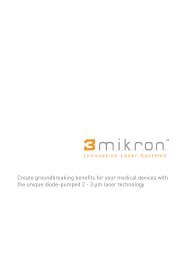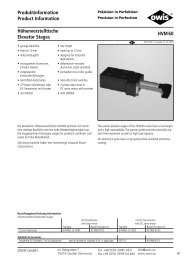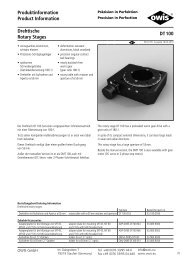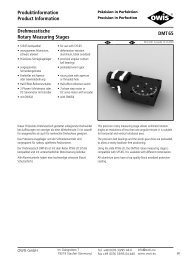Infrared Gas Imaging and Quantification Camera ... - Energy laser Srl
Infrared Gas Imaging and Quantification Camera ... - Energy laser Srl
Infrared Gas Imaging and Quantification Camera ... - Energy laser Srl
You also want an ePaper? Increase the reach of your titles
YUMPU automatically turns print PDFs into web optimized ePapers that Google loves.
Figure 8. St<strong>and</strong>ard setup for concentration calibration of the Sherlock camera using st<strong>and</strong>ard gascells.CONCLUSIONAn infrared spectral imaging battery operated camera, useful for gas imaging, quantification <strong>and</strong>analysis was developed by Pacific Advanced Technology. An exclusive world wide license hasbeen granted to <strong>Gas</strong> <strong>Imaging</strong> Technology for the use of Sherlock in the oil, gas, chemical <strong>and</strong>power industry. The Sherlock has been extensively tested by industry, <strong>and</strong> EPA/API sponsoredlaboratory testing at BP Naperville in the spring of 2005. As a result of this testing, Sherlockdemonstrated that it has the sensitivity to be used as an optical imaging instrument for thealternate work practice to Method 21. Sherlock has demonstrated that it can see hydrocarbonleak rates as low as 5 ccm, <strong>and</strong> measured concentrations of fugitive gases in the field as low as afew thous<strong>and</strong> ppm.The Sherlock is an autonomous system with an embedded Power PC computer, <strong>and</strong> real timeimage processing implemented in FPGA's. It can be controlled over an ethernet link from remotelocations throughout the world. The architecture of the camera is such that easy upgrades can bemade by changes in software for various <strong>and</strong> differing applications such as fugitive leak imaging<strong>and</strong> quantification, remote monitoring of flare, stacks <strong>and</strong> continuous monitoring of plants fordetection of leaks that can be a safety hazard to plant operations.Through both laboratory <strong>and</strong> field testing Sherlock has shown that it has the sensitivity to beapplied to fugitive leak detection, imaging <strong>and</strong> quantifications. Field test at the ENI SpAproduction facility in southern Italy demonstrated the quantification capability of the Sherlock.When the results of the concentrations measurements made by Sherlock were compared tomeasurements of the same leaking component with an FID device, reasonable correlation wasdemonstrated. However, to better underst<strong>and</strong> the accuracy of the Sherlock’s quantification,further testing is required. It is anticipated that future field trials will be performed along withbagging techniques to better underst<strong>and</strong> the accuracy of the Sherlock measurements.8
ACKNOWLEDGEMENTSThe authors would like to acknowledge many individuals <strong>and</strong> corporations who contributed tothe Sherlock development over the years. The development of the Sherlock camera has beensupported by funds from the Department of <strong>Energy</strong> through an SBIR program, <strong>and</strong> the State ofCalifornia though a technology transfer program. Matching funds have been contributed by <strong>Gas</strong>Technology Institute, BP, Shell Global Solutions, Royal Dutch Shell <strong>and</strong> ENI Technology. Wewould also like to thank Jeff Panek of Innovative Environmental Solutions, Inc. for hiscounseling over the years <strong>and</strong> Dave Fashimpaur of BP for his continuing support of our efforts torefine the Sherlock as a useful instrument for industry.References:[1] Michele Hinnrichs, James Jensen, Gerald McAnally, “H<strong>and</strong>held Hyperspectral Imager forSt<strong>and</strong>off Detection of Chemical <strong>and</strong> Biological Aerosols, SPIE Photonics East October 27-31, 2003.[2] Michele Hinnrichs, “<strong>Imaging</strong> Spectrometer for Fugitive <strong>Gas</strong> Leak Detection”,Environmental <strong>and</strong> Industrial Sensing, SPIE, Boston September 19-20, 1999.[3] Michele Hinnrichs "Remote Sensing for <strong>Gas</strong> Plume Monitoring Using State-of-the-art<strong>Infrared</strong> Hyperspectral <strong>Imaging</strong>", SPIE, Industrial <strong>and</strong> Environmental Monitors <strong>and</strong>Biosensors Nov 2-5, 1998.[4] Michele Hinnrichs, Mark Massie “New Approach to <strong>Imaging</strong> Spectroscopy UsingDiffractive Optics”, SPIE San Diego, July 1997.[5] Michele Hinnrichs, Mark Massie <strong>and</strong> Jeff Frank (Amber), “Hyperspectral <strong>Imaging</strong>Radiometer Using Staring 128 x 128 InSb Focal Plane Array <strong>and</strong> Dispersive Techniques”,SPIE AeroSense 1995, <strong>Imaging</strong> Spectroscopy Session, Orl<strong>and</strong>o, 1995.[6] www.gitint.com9








